AMD Ryzen 7 8700G and Ryzen 5 8600G Review: Zen 4 APUs with RDNA3 Graphics
by Gavin Bonshor on January 29, 2024 9:00 AM EST- Posted in
- CPUs
- AMD
- APUs
- Phoenix
- 4nm
- Zen 4
- RDNA3
- AM5
- Ryzen 8000G
- Ryzen 7 8700G
- Ryzen 5 8600G
CPU Benchmark Performance: Rendering
Rendering tests, compared to others, are often a little more simple to digest and automate. All the tests put out some sort of score or time, usually in an obtainable way that makes it fairly easy to extract. These tests are some of the most strenuous in our list, due to the highly threaded nature of rendering and ray-tracing, and can draw a lot of power.
If a system is not properly configured to deal with the thermal requirements of the processor, the rendering benchmarks are where it would show most easily as the frequency drops over a sustained period of time. Most benchmarks, in this case, are re-run several times, and the key to this is having an appropriate idle/wait time between benchmarks to allow for temperatures to normalize from the last test.
Some of the notable rendering-focused benchmarks we've included for 2024 include the latest CineBench 2024 benchmark and an update to Blender 3.6 and V-Ray 5.0.2.
We are using DDR5-5200 memory as per the JEDEC specifications on the Ryzen 7 8700G and Ryzen 5 8600G, as well as DDR4-3200 on the Ryzen 7 5700G and Ryzen 5 5600G. The same methodology is also used for the AMD Ryzen 7000 series and Intel's 14th, 13th, and 12th Gen processors. Below are the settings we have used for each platform:
- DDR5-5200 CL44 - Ryzen 8000G
- DDR4-3200 CL22 - Ryzen 5000G
- DDR5-5600B CL46 - Intel 14th & 13th Gen
- DDR5-5200 CL44 - Ryzen 7000
- DDR5-4800 (B) CL40 - Intel 12th Gen
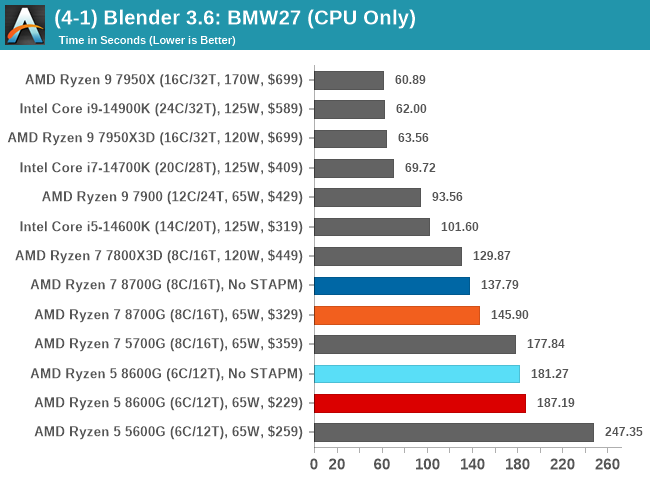
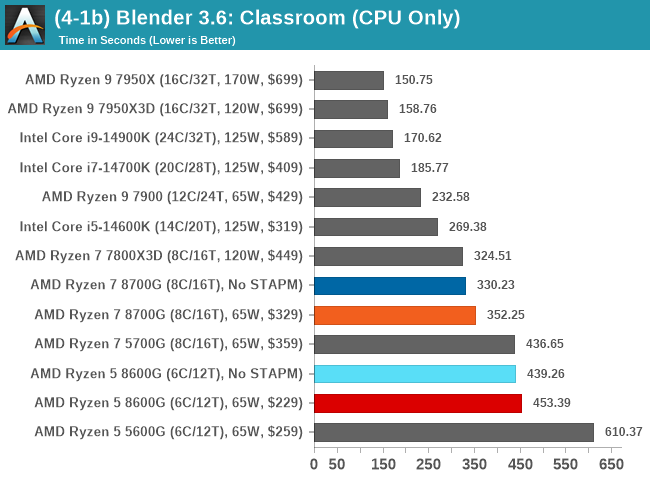
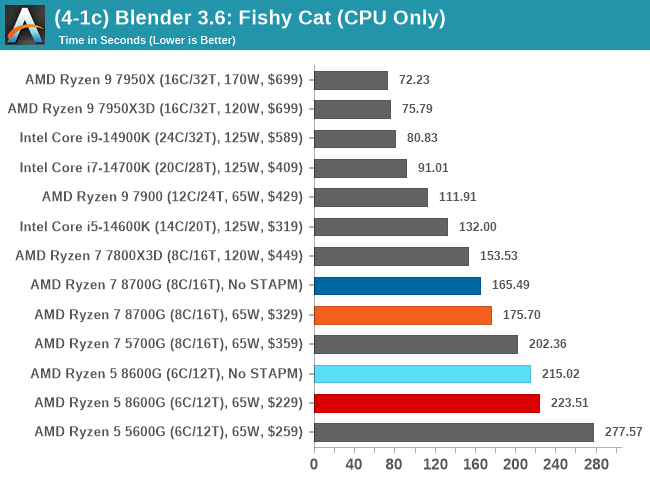
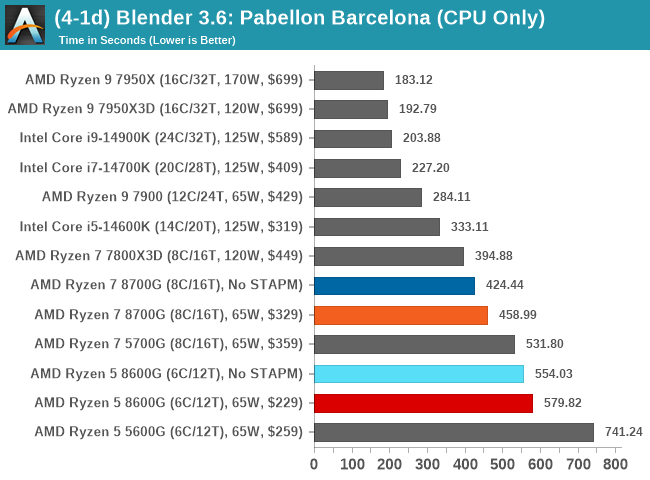

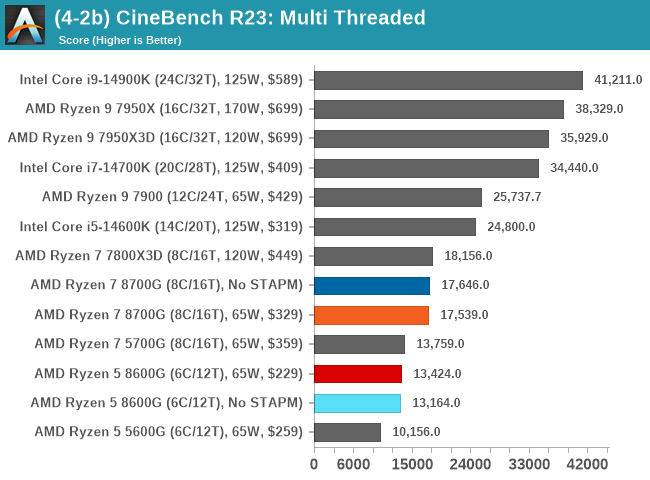
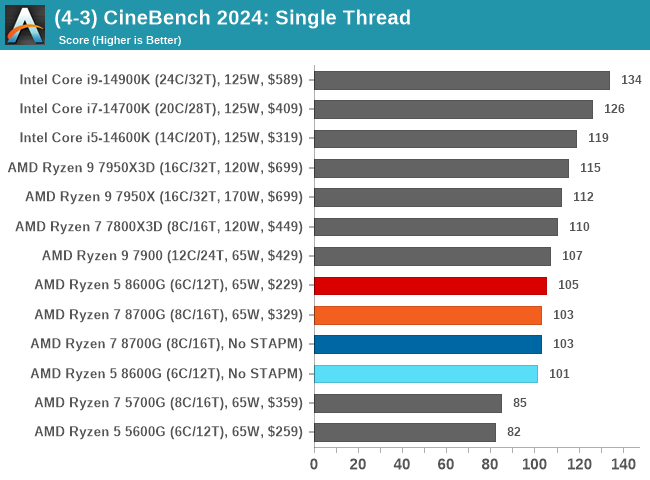
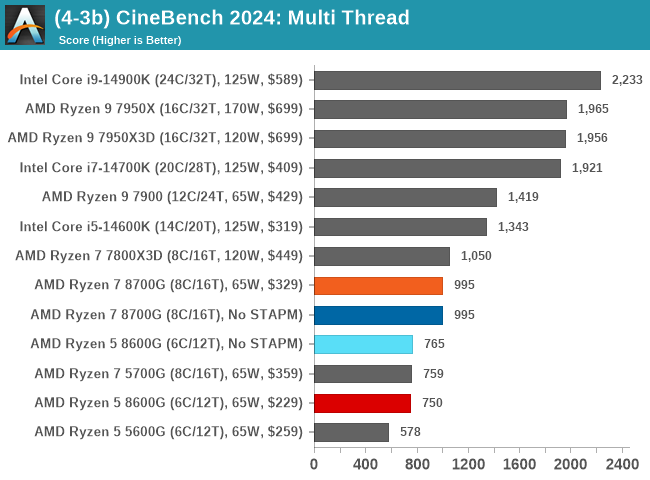

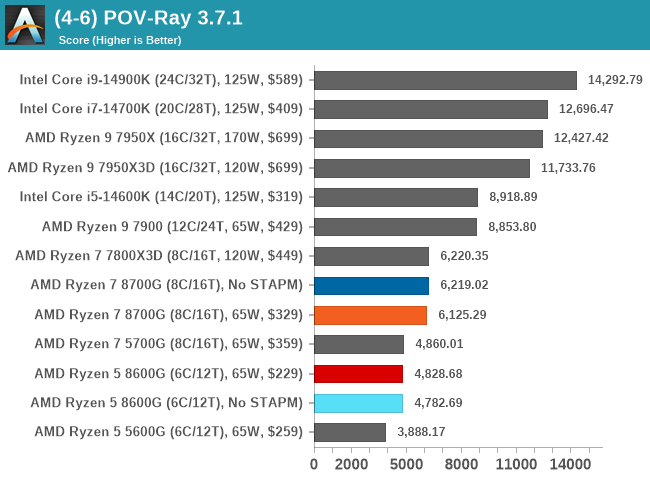
Another area where a mobile-based chip ported to a desktop doesn't quite match the bigger desktop chips is in rendering, a quintessential power and multi-threaded scenario where more cores and threads typically equate to higher performance. Both the Ryzen 7 8700G and Ryzen 5 8600G beat out the Ryzen 5000G series APUs, although the Ryzen 7 5700G consistently beats the Ryzen 5 8600G as we would expect from having two more cores with four more threads.
In our rendering tests without STAPM limitations, we saw notable gains in performance in Blender 3.6. The performance increase without sustained power loads being limited, we're seeing up to 7.5% better performance across the longer tests, with around 5% more performance in the shorter tests.










111 Comments
View All Comments
t.s - Tuesday, January 30, 2024 - link
well, I care.goatfajitas - Tuesday, January 30, 2024 - link
I do see your point. You can put in some high end cooling and take advantage of the speed. That still doesnt fix the fact that it runs extremely hot and power hungry compared to its competition.ricebunny - Tuesday, January 30, 2024 - link
Highly dependent on application. In games they pull around 125W, roughly the same as high end Zen 4 CPUs.goatfajitas - Tuesday, January 30, 2024 - link
"Highly dependent on application. In games they pull around 125W, roughly the same as high end Zen 4 CPUs."Agreed on some setups. I have seen some equivalently equipped SFF/Tiny desktop setups (with obviously limited thermals) and Intel drops off alot earlier. The point being it runs too hot.
WaffleTech - Sunday, February 4, 2024 - link
"roughly the same"ComputerBase measured this over more than a dozen games and on average it's 149W for the 14900K and 72W for the 7950X3D, which is less than half. Even the Non-X3D 7950X with 105W uses almost 30% less in games.
Thunder 57 - Tuesday, January 30, 2024 - link
It's the enormous heat output that is the problem, not the electric bill.yankeeDDL - Thursday, February 1, 2024 - link
"no issue"? Are you joking?Cost aside, to dissipate 400+W you need massive cooling, and the MoBo needs to be way over-designed.
Intel peaks at 4x the power of Ryzen to, maybe, marginally beat it in few benchmarks. That's not irrelevant at all: this kind of delta in efficiency applies also on mobile (albeit not so extreme): that translates in battery life (and slower performance, as on laptops you can't peak at those levels).
is4u2p - Wednesday, January 31, 2024 - link
Was this in the 12th gen mobile CPUs?lakedude - Friday, February 9, 2024 - link
"Peak power is an irrelevant metric." maybe to you.Going AMD this time allowed me to save money on the cooler and the power supply. Gonna save money on electricity as well.
I hate the way Intel plays games with their TDP these days. Don't say something is 125w TDP if it can pull over 300w. Call it a 300w chip that can be underclocked or power capped to 125w. Or have it only pull 125w out of the box rather than leave it up to the user to fiddle around with turning it down.
wwenze - Monday, February 5, 2024 - link
Well, Intel definitely has the advantage when it comes to "not dying when pushed hard" or even "not dying when running at the actual stated specs" but outdate efficiency/IPC, while AMD is the opposite on both fronts.So Intel put the pieces together and said "what if we clock it until 250W turbo TDP while the competition only has 100W at that price point"